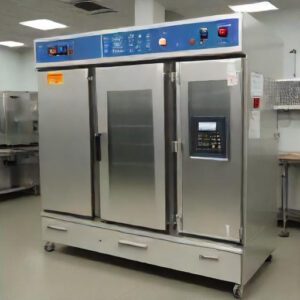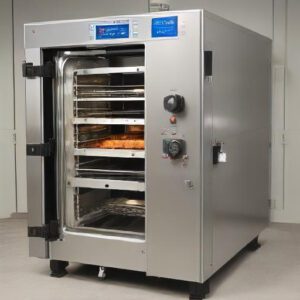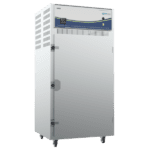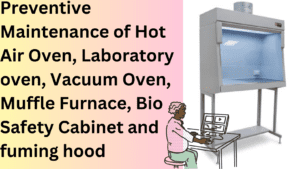Hot Air Oven principle and applications of hot air ovens in pharmaceutical laboratories. Understand how dry heat sterilization ensures safe and effective sterilization and drying. Understand the role of hot air ovens in pharmaceutical labs. Learn about their dry heat sterilization principle, applications for sterilizing glassware, drying samples, and ensuring product stability. The hot air oven is a critical piece of equipment in pharmaceutical laboratories, primarily used for sterilization, drying, and quality control of various materials and instruments. The principle behind its operation involves the use of dry heat to achieve the desired outcomes. Here’s a detailed look at how this principle is applied in pharmaceutical laboratories.

Hot Air Oven Principle :
The principle of a hot air oven is based on dry heat sterilization. It operates by circulating hot air around the objects placed inside, ensuring that heat is evenly distributed and effectively sterilizes the materials. The typical temperature range is between 50°C and 300°C. The process involves conduction, convection, and radiation:
- Conduction: Heat transfers from the hot air to the surface of the objects.
- Convection: The movement of hot air within the oven facilitates uniform heating.
- Radiation: Heat radiates from the heating elements to the objects.
The dry heat destroys microorganisms through oxidation, effectively breaking down their cellular components and rendering them non-viable.
Parts of a Hot Air Oven:
- Cabinet: The outer shell that provides insulation and protection. It is usually made of stainless steel or mild steel.
- Insulation: Thick layers of insulation material surround the chamber to prevent heat loss and ensure efficient energy use.
- Heating Elements: These are typically located at the bottom or around the chamber and are responsible for generating heat.
- Thermostat/Temperature Controller: This component regulates the oven’s temperature, ensuring it remains constant.
- Air Circulating Fan: Ensures uniform distribution of heat by circulating the air within the chamber.
- Shelves/Racks: Adjustable shelves allow for the placement of items to be heated or sterilized.
- Door: Equipped with a seal to maintain the internal temperature and prevent heat loss.
- Ventilation: Provides controlled exhaust of air to avoid pressure build-up and facilitate moisture removal.

Types of Hot Air Ovens:
- Gravity Convection Ovens: Rely on natural air convection for heat distribution. They are simpler and more cost-effective but may have less uniform heat distribution.
- Mechanical Convection Ovens: Use fans to circulate the air, ensuring more uniform temperature throughout the chamber. They are more efficient for precise heating requirements.
- Vacuum Ovens: These operate under reduced pressure, which allows for lower temperature sterilization, ideal for heat-sensitive materials.
- Forced Air Ovens: Similar to mechanical convection ovens but typically have a more powerful air circulation system for even greater uniformity and efficiency.
Temperature Mapping and Validation of Hot Air Oven:
Temperature mapping and validation are critical processes to ensure that a hot air oven operates within specified parameters, providing uniform heat distribution and consistent sterilization results. Here is a detailed table outlining the key steps and considerations in temperature mapping and validation for a hot air oven:
| Step | Description | Purpose |
| 1. Pre-Validation Check | Inspect the oven for cleanliness, proper functioning, and calibration of sensors and controllers. | Ensure the oven is in optimal working condition before validation. |
| 2. Define Mapping Protocol | Develop a detailed protocol outlining the validation process, including objectives, equipment, and criteria. | Provide a clear plan for conducting temperature mapping and validation. |
| 3. Place Sensors | Position temperature sensors (thermocouples or data loggers) at various locations inside the oven. | Measure temperature at different points to ensure uniform heat distribution. |
| 4. Perform Empty Chamber Test | Run the oven empty and record temperature data at specified intervals over a complete cycle. | Establish baseline temperature distribution without any load. |
| 5. Load Validation | Load the oven with typical items to be sterilized and repeat the temperature recording process. | Assess the temperature distribution under normal operating conditions. |
| 6. Analyze Data | Compare temperature readings from different sensors to identify any variations or hotspots. | Ensure temperature uniformity and compliance with specified ranges. |
| 7. Adjust and Re-Test | Make necessary adjustments based on data analysis and repeat the validation process if required. | Achieve optimal temperature uniformity and consistency. |
| 8. Documentation | Compile a comprehensive validation report, including all data, analyses, and any corrective actions taken. | Provide evidence of compliance with validation requirements and regulatory standards. |
| 9. Routine Monitoring | Implement regular temperature monitoring and periodic re-validation to ensure ongoing compliance. | Maintain consistent oven performance over time. |
Key Considerations for Temperature Mapping and Validation:
- Sensor Placement: Ensure sensors are placed in critical areas, including corners, center, and near the door, to capture a comprehensive temperature profile.
- Calibration: Regular calibration of sensors and controllers is essential to maintain accuracy.
- Environmental Factors: Consider external factors like ambient temperature and airflow, which may affect the oven’s performance.
- Documentation: Thorough documentation of all procedures, findings, and adjustments is necessary for regulatory compliance and future reference.
- Frequency of Validation: Perform initial validation upon installation, followed by periodic re-validation (e.g., annually) and after any significant repairs or modifications.
By following these steps and maintaining rigorous documentation, pharmaceutical laboratories can ensure that their hot air ovens provide reliable and consistent sterilization, thereby meeting stringent quality and safety standards.
Uses of Hot Air Ovens:
- Sterilization: Widely used in laboratories and medical facilities to sterilize surgical instruments, glassware, and other equipment.
- Drying: Essential in industries such as pharmaceuticals, food processing, and materials science for drying samples and products.
- Baking: Used in manufacturing processes for curing and baking materials like powders, pastes, and coatings.
- Heat Treatment: Employed in metallurgy and materials engineering to alter the properties of metals and alloys.
- Quality Control: Utilized in various industries for stability testing of products under controlled heat conditions.
Examples of Hot Air Oven Applications:
- Medical Laboratories: Sterilizing surgical tools, glassware, and other laboratory instruments to ensure they are free from microbial contamination.
- Pharmaceutical Industry: Drying powders and other materials, sterilizing containers, and conducting stability tests.
- Food Industry: Drying and baking food samples to test for moisture content and shelf-life.
- Electronics Manufacturing: Curing coatings on electronic components to enhance durability and performance.
- Research and Development: Used in materials science to test the effects of prolonged heat exposure on different materials.
Major Suppliers of Hot Air Ovens:
- Thermo Fisher Scientific
- Overview: A leading supplier of scientific instruments, including high-quality hot air ovens.
- Products: Offers a range of laboratory ovens with advanced features for precise temperature control and uniform heat distribution.
- Website: Thermo Fisher Scientific
- Memmert GmbH + Co. KG
- Overview: A renowned German manufacturer specializing in laboratory ovens, incubators, and climate chambers.
- Products: Provides a variety of hot air ovens known for their reliability and advanced technological features.
- Website: Memmert
- Binder GmbH
- Overview: A leading provider of simulation chambers, Binder offers high-performance hot air ovens for various applications.
- Products: Known for precision and uniform heating, suitable for demanding laboratory environments.
- Website: Binder
- Yamato Scientific America Inc.
- Overview: Offers a comprehensive range of laboratory equipment, including hot air ovens with innovative design and functionality.
- Products: Provides efficient and reliable ovens for drying, sterilizing, and other laboratory needs.
- Website: Yamato Scientific
- Thermoline Scientific
- Overview: An Australian company known for manufacturing and supplying a wide range of laboratory equipment, including hot air ovens.
- Products: Offers durable and efficient hot air ovens designed for laboratory and industrial use.
- Website: Thermoline Scientific
- Tanco Lab Products (Tanco Group)
- Overview: A leading manufacturer of laboratory and scientific equipment in India.
- Products: Offers a wide range of hot air ovens with features like digital temperature control, uniform heat distribution, and robust construction.
- Website: Tanco Lab Products
- Bionics Scientific Technologies (P) Ltd.
- Overview: A prominent manufacturer and supplier of laboratory and scientific equipment, including hot air ovens.
- Products: Provides hot air ovens suitable for various applications in research, pharmaceutical, and industrial laboratories.
- Website: Bionics Scientific
- Macro Scientific Works Pvt. Ltd.
- Overview: A well-known name in the laboratory equipment manufacturing sector in India.
- Products: Offers a range of hot air ovens with advanced features for precise temperature control and uniform heating.
- Website: Macro Scientific Works
- Rivotek India
- Overview: A manufacturer and exporter of a wide range of laboratory equipment.
- Products: Specializes in hot air ovens that cater to the needs of research laboratories, educational institutions, and industrial applications.
- Website: Rivotek India
- Metrex Scientific Instruments Pvt. Ltd.
- Overview: A reputed manufacturer and supplier of laboratory instruments and equipment.
- Products: Offers high-quality hot air ovens designed for reliable performance and precise temperature control.
- Website: Metrex Scientific Instruments
- Labline Instruments
- Overview: A leading supplier of laboratory equipment, including hot air ovens, known for their durability and efficiency.
- Products: Provides a variety of hot air ovens suitable for scientific research and industrial use.
- Website: Labline Instruments
- Technico Laboratory Products Pvt. Ltd.
- Overview: An established manufacturer of laboratory equipment, known for its quality and innovation.
- Products: Offers a range of hot air ovens that meet the specific needs of laboratories and industrial applications.
- Website: Technico Laboratory Products
- Acmas Technologies Pvt. Ltd.
- Overview: A key player in the manufacturing of scientific and laboratory instruments.
- Products: Provides reliable and efficient hot air ovens with advanced features for precise temperature control and uniform heat distribution.
- Website: Acmas Technologies
- Newtronics Lab Instruments
- Overview: Specializes in manufacturing laboratory equipment, including hot air ovens.
- Products: Known for high-quality hot air ovens that ensure uniform heating and are suitable for various laboratory applications.
- Website: Newtronics Lab Instruments
Frequently asked questions:
What is the working principle of hot air oven?
Answer: The working principle of a hot air oven is based on dry heat sterilization. The oven uses heating elements to generate hot air, which is circulated evenly within the chamber by convection. This heat transfers to the objects, raising their temperature and causing microbial death through oxidative processes, effectively sterilizing the materials.
What is the principle of pharmaceutical oven?
Answer: The principle of a pharmaceutical oven is similar to that of a hot air oven, focusing on dry heat to sterilize equipment and materials. It ensures uniform heat distribution through either natural or forced convection, maintaining precise temperature control to meet stringent pharmaceutical standards.
What is the use of hot air oven in pharmaceutical industry?
Answer: In the pharmaceutical industry, hot air ovens are used for:
- Sterilizing glassware, metal instruments, and containers.
- Drying powders and granules.
- Performing stability tests on pharmaceutical products.
- Depyrogenation of glass vials and other equipment by removing pyrogens through high temperatures.
What is the principle of heat in the oven?
Answer: The principle of heat in an oven involves the generation and uniform distribution of hot air within a confined space. This is achieved through conduction, convection (either natural or forced), and sometimes radiation, ensuring that the temperature is evenly maintained throughout the chamber for consistent heating or sterilization.
What is the principle of hot air oven?
Answer: According to Wikipedia, the principle of a hot air oven is based on using dry heat to sterilize materials. The hot air, circulated by convection, raises the temperature of the objects inside, destroying microorganisms by oxidation, thereby achieving sterilization.
What is the principle of autoclave and hot air oven?
Answer: The principle of an autoclave is based on moist heat sterilization, using steam under pressure to achieve higher temperatures than boiling water, effectively killing microorganisms, including spores. In contrast, a hot air oven uses dry heat, circulating hot air to oxidize and destroy microbial life. Both methods ensure sterilization but use different forms of heat.
What are the advantages of hot air oven?
Answer:
- No use of moisture, making it suitable for sterilizing moisture-sensitive items.
- High penetration power and ability to sterilize oils and powders.
- Non-corrosive to metal instruments.
- Simple operation and cost-effective maintenance.
Which instrument used in hot air oven?
Answer: The key instrument used in a hot air oven is the thermostat/temperature controller, which regulates the temperature. Additional instruments include heating elements, air circulating fans, and temperature sensors.
What is the difference between hot air oven and autoclave?
Answer: Difference Between Hot Air Oven and Autoclave
- Heat Source: Hot air ovens use dry heat; autoclaves use moist heat (steam).
- Temperature Range: Hot air ovens typically operate between 50°C and 300°C; autoclaves operate around 121°C to 134°C.
- Sterilization Method: Hot air ovens oxidize microorganisms; autoclaves use steam under pressure to denature proteins.
- Application: Hot air ovens are suitable for heat-stable, moisture-sensitive items; autoclaves are used for items that can withstand moisture and higher pressure.
How to use a hot air oven?
Answer: How to Use a Hot Air Oven
- Preheat: Set the desired temperature and allow the oven to preheat.
- Load Items: Place items on the shelves, ensuring they are not overcrowded.
- Set Timer: Adjust the timer according to the sterilization requirements.
- Start Cycle: Close the door and start the cycle.
- Monitor: Periodically check the temperature and process.
- Cool Down: After the cycle, allow items to cool inside the oven before remova
What are the precautions of a hot air oven?
Answer: Precautions of a Hot Air Oven
- Avoid overloading to ensure proper air circulation.
- Use appropriate temperature settings to avoid damaging items.
- Regularly calibrate and maintain the thermostat.
- Ensure the door seal is intact to maintain temperature.
- Handle hot items with protective gear to avoid burns.
What is autoclave principle?
Answer: The principle of an autoclave is based on steam sterilization. It uses steam under high pressure to reach temperatures above 100°C, typically around 121°C to 134°C. The steam penetrates materials, denaturing proteins and effectively killing microorganisms, including spores, ensuring sterilization.
How to clean a hot air oven?
Answer: How to Clean a Hot Air Oven
- Unplug: Ensure the oven is turned off and unplugged.
- Cool Down: Allow the oven to cool completely.
- Remove Shelves: Take out the shelves and clean them separately.
- Wipe Interior: Use a damp cloth with mild detergent to wipe the interior surfaces.
- Dry: Allow the oven to dry completely before use.
What is the principle of sterilization?
Answer: The principle of sterilization involves the complete elimination or destruction of all forms of microbial life, including bacteria, viruses, spores, and fungi. This can be achieved through physical methods like heat (dry or moist), filtration, radiation, or chemical methods using sterilizing agents. By understanding these principles and procedures, users can effectively operate and maintain hot air ovens and autoclaves, ensuring high standards of sterilization and safety in various applications.



